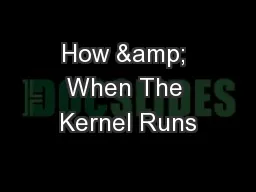PPT-Countering Kernel
Author : cheryl-pisano | Published Date : 2017-05-06
Rootkits with lightweight Hook Protection Authors Zhi Wang Xuxian Jiang Weidong Cui Peng Ning Presented by Purva Gawde Outline Introduction Prior research
Presentation Embed Code
Download Presentation
Download Presentation The PPT/PDF document "Countering Kernel" is the property of its rightful owner. Permission is granted to download and print the materials on this website for personal, non-commercial use only, and to display it on your personal computer provided you do not modify the materials and that you retain all copyright notices contained in the materials. By downloading content from our website, you accept the terms of this agreement.
Countering Kernel: Transcript
Download Rules Of Document
"Countering Kernel"The content belongs to its owner. You may download and print it for personal use, without modification, and keep all copyright notices. By downloading, you agree to these terms.
Related Documents














